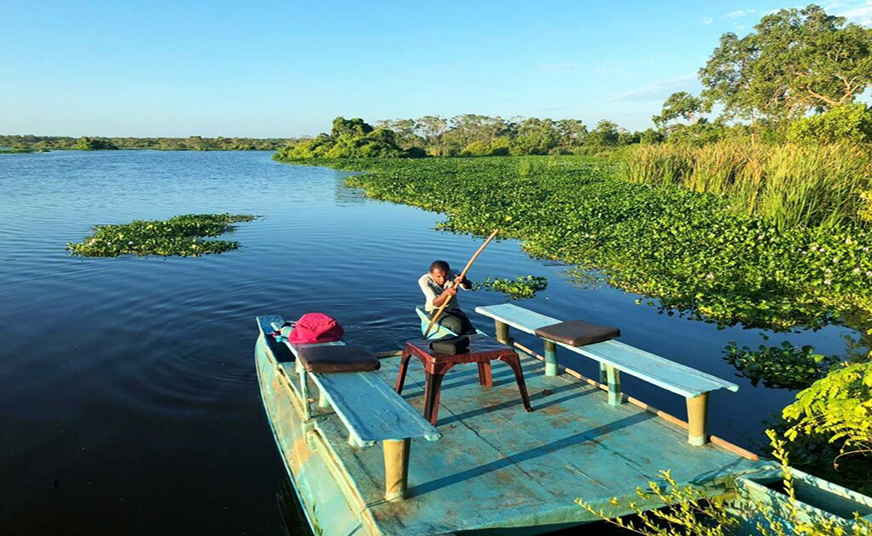Kalamatiya Lagoon
Kalamatiya Lagoon and Bird Sanctuary
Destination Overview
Kalamatiya Lagoon and Bird Sanctuary, located in the Hambantota District of Southern Sri Lanka, is a tranquil haven for nature lovers, bird watchers, and those seeking a peaceful retreat in a coastal environment. This lagoon is part of a large wetland ecosystem, rich in biodiversity, and offers a unique opportunity to explore the natural beauty of Sri Lanka's southern coast. The area is known for its bird sanctuary, which provides a habitat for both migratory and resident bird species, making it a popular destination for birdwatching and nature photography.
The Kalamatiya Lagoon and Bird Sanctuary are relatively less known than other natural attractions in Sri Lanka, which makes it a perfect off-the-beaten-path destination for travelers looking to experience Sri Lanka’s wilderness away from the crowds. The serene beauty of the lagoon, combined with the diverse wildlife and lush landscapes, provides an immersive experience in nature.
Historical and Cultural Significance
Although the Kalamatiya Lagoon is more renowned for its natural significance, it holds value as a cultural and historical landmark in the region. The surrounding communities have lived harmoniously with the lagoon’s ecosystem for generations, relying on its resources for livelihood, particularly through fishing and traditional practices.
- Traditional Fishermen's Communities:
The people living in and around the Kalamatiya Lagoon have long relied on its waters for fishing, using traditional boats and techniques passed down through generations. These communities maintain a close relationship with the lagoon, respecting its role in their daily lives. - Conservation Efforts:
The establishment of the Kalamatiya Bird Sanctuary has played an important role in conserving the area’s rich ecosystem. It helps protect the lagoon and its surrounding habitats, ensuring the continued presence of endangered species of birds and wildlife.
Attractions and Highlights
1.Birdwatching:
The Kalamatiya Bird Sanctuary is home to more than 150 species of birds, making it one of Sri Lanka’s most important birdwatching spots. The lagoon attracts a range of resident and migratory bird species, including waders, waterfowl, and raptors. Among the notable species are:
- Greater Flamingos
- Painted Storks
- Egret species
- Grey Herons
- Ospreys
- Migratory ducks
Visitors can enjoy bird watching from designated viewing points or boats that allow access to quieter, more remote sections of the lagoon.
2.Kalamatiya Lagoon:
The lagoon itself is a scenic waterbody that forms a natural habitat for a range of aquatic life. The serene waters are bordered by mangrove forests, salt marshes, and wetlands, creating a unique landscape that is both visually stunning and ecologically significant. The lagoon is particularly beautiful during sunset, when the light reflects off the water and the surrounding environment takes on a magical glow.
3.Boat Tours:
A boat ride through the Kalamatiya Lagoon offers an up-close view of the diverse wildlife and rich vegetation that line the shores. Tour guides, many of whom are local fishermen, offer eco-friendly boat tours that take visitors to birdwatching hotspots within the sanctuary. This is one of the best ways to explore the lagoon and learn about its history and ecology.
4.Mangrove Forests:
The mangrove forests surrounding Kalamatiya Lagoon are vital to the ecosystem, providing breeding grounds for various species of fish and shelter for many animals. Visitors can enjoy guided walks around the area to learn about the importance of these forests in maintaining the environmental balance.
5.Fishing and Traditional Life:
If you’re interested in the local lifestyle, you may have the chance to experience traditional fishing methods or interact with local communities who depend on the lagoon for their livelihood. Some eco-lodges or local guides offer immersive experiences where visitors can go fishing with the locals or enjoy freshly caught seafood.
Facilities and Amenities
While Kalamatiya Lagoon and Bird Sanctuary remain relatively untouched by mass tourism, the area does offer basic facilities for visitors who wish to enjoy the sanctuary’s beauty.
- Eco-Lodges:
There are several eco-friendly lodges and guesthouses in the nearby areas, such as in Hambantota or near the Kalamatiya Lagoon. These accommodations offer simple but comfortable stays with a focus on sustainability and nature conservation. Staying in these eco-lodges gives guests an authentic experience of the local culture and environment. - Boat Tours and Guides:
Boat tours are available through local operators and guides. Most of these boat rides are eco-friendly, with local boatmen acting as guides to explain the natural history of the area and identify bird species and wildlife. - Visitor Center:
The Kalamatiya Bird Sanctuary has a small visitor center where you can get maps, information, and suggestions for activities in the sanctuary. The center may also have informational displays about the local birds and the importance of the lagoon in preserving wildlife. - Rest Areas and Picnic Spots:
Some parts of the sanctuary offer small resting areas for visitors to relax, enjoy a picnic, and take in the natural surroundings.
Travel Information
- Getting There:
The Kalamatiya Lagoon is located near Hambantota, about 30 km from Tissamaharama and around 15 km from the Mirijjawila area. Visitors can reach the lagoon by private car, taxi, or local transport.
By Car: From Colombo, it takes approximately 4-5 hours (via the A2 highway) to reach the Kalamatiya area. From Tissamaharama or Hambantota, the lagoon is easily accessible by car or tuk-tuk.
By Public Transport: While there are buses to Hambantota and Tissamaharama, it is easier to access the lagoon by tuk-tuk or private transport once you reach the nearby town. - Best Time to Visit:
The best time to visit the Kalamatiya Lagoon and Bird Sanctuary is during the migrant bird season from November to March, when a variety of migratory birds make their way to the lagoon. However, the sanctuary can be visited year-round, with the wet season (May to October) providing lush landscapes and rich green scenery. - Local Currency:
The Sri Lankan Rupee (LKR) is the local currency. ATMs are available in Hambantota and Tissamaharama, but it is best to carry cash as some of the remote areas may not have easy access to ATMs.
Safety Guidelines
- Respect Wildlife:
When visiting the sanctuary, always maintain a respectful distance from the birds and wildlife. Do not disturb the animals or attempt to feed them. Ensure that you do not make loud noises that could scare the birds away, especially during the breeding season. - Protect the Environment:
As this is a protected eco-system, it’s important to keep the environment clean. Carry all your trash with you and use eco-friendly products. Respect the local communities and their way of life. - Health & Safety:
As the area can be humid and tropical, be sure to stay hydrated, wear sunscreen, and protect yourself from insects (especially mosquitoes) by using repellent. If you plan to take a boat tour, ensure that the boat is equipped with safety gear.
Conclusion
Kalamatiya Lagoon and Bird Sanctuary is an exceptional destination for those seeking a peaceful natural retreat, rich in wildlife, birdwatching, and eco-tourism. The area’s scenic landscapes, vibrant bird species, and serene lagoon make it an ideal spot for nature lovers, photographers, and those interested in conservation. Whether you’re here for a boat tour, birdwatching, or simply to enjoy the natural beauty, Kalamatiya offers a unique and peaceful experience in Sri Lanka’s southern wilderness.








